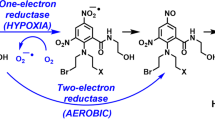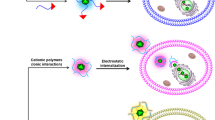Abstract
Improving the therapeutic potential of adenoviral (Ad) suicide gene therapy has become an area of intense investigation since the inception of gene therapy strategies for cancer treatment. Poor efficiency of gene transfer to target tissues has become one of the most important limitations to Ad-based gene therapy. Since polycations have been shown to enhance adenovirus-mediated gene transfer in epithelial cells both in vitro and in vivo, we hypothesized that polycations could augment treatment efficacy in animals with established tumor. To address this hypothesis, protamine sulfate, a polycation already safely administered in humans, was complexed with a recombinant Ad (E1E3-deleted) vector containing the herpes simplex 1 thymidine kinase (HSVtk) suicide gene to treat cancer cell lines in vitro and in animals bearing intraperitoneal tumor. In the presence of 5 μg/ml protamine, the efficiency of gene transfer to a number of cancer cell lines normally resistant to adenovirus was significantly enhanced. Protamine’s effect in vitro was found to be inversely proportional to the level of expression of the high affinity Ad binding site, coxsackievirus and adenovirus receptor (CAR), on the sur- face of the various cell lines tested. Ad.tk infected tumor cells were rendered 2.5- to three-fold more sensitive to 20 μM ganciclovir (GCV) in the presence of protamine. Protamine also augmented the in vivo transfer efficiency of the marker gene, LacZ (contained in an Ad vector), on the surface of tumors derived from an intraperitoneal mouse model. Quantitative imaging revealed 50% tumor surface transduced with LacZ when treatment was performed in the presence of 50 μg/ml protamine compared with 12% tumor surface in controls. However, experiments performed utilizing intraperitoneal administration of Ad.tk/GCV in the presence or absence of 50 μg/ml protamine demonstrated no significantly improved median survival in mice bearing established intraperitoneal tumors. Similarly, in Fischer rats bearing intrapleural tumor, no improvement in anti-tumor response was observed when Ad treatment was performed intrapleurally in the presence of protamine. Thus, although protamine induced an enhancement of Ad-mediated gene transfer in vitro and in vivo, its use as an adjunct to intracavitary Ad-based cancer gene therapy in vivo appears to be limited.
This is a preview of subscription content, access via your institution
Access options
Subscribe to this journal
Receive 12 print issues and online access
$259.00 per year
only $21.58 per issue
Buy this article
- Purchase on Springer Link
- Instant access to full article PDF
Prices may be subject to local taxes which are calculated during checkout






Similar content being viewed by others
References
Miller AD . Human gene therapy comes of age Nature 1992 357: 455–460
Moolten FL . Drug sensitivity (‘suicide’) genes for selective cancer chemotherapy Cancer Gene Ther 1994 1: 279–287
St Clair MH, Lambe CU, Furman PA . Inhibition by ganciclovir of cell growth and DNA synthesis of cells biochemically transformed with herpes virus genetic information Antimicrob Agents Chemother 1987 31: 844–849
Pinedo HM, Peters GFJ . Fluorouracil: biochemistry and pharmacology J Clin Oncol 1988 6: 1653–1644
Mathews T, Boehme R . Antiviral activity and mechanism of action of ganciclovir Rev Infect Dis 1988 10: S490–S494
Moolten FL, Wells JM . Curability of tumors bearing herpes thymidine kinase genes transferred by retroviral vectors J Natl Cancer Inst 1990 82: 297–300
Huber BE et al. In vivo anti-tumor activity of 5-fluorocytosine on human colorectal carcinoma cells genetically modified to express cytosine deaminase Cancer Res 1993 53: 4619–4626
Bett AJ, Prevec L, Graham FL . Packaging capacity and stability of human adenovirus type 5 vectors J Virol 1993 67: 5911–5921
Kozarsky KF, Wilson JM . Gene therapy: adenovirus vectors Curr Opin Genet Dev 1993 3: 499–503
Goodman JC et al. Adenovirus-mediated thymidine kinase gene transfer into the primate brain followed by systemic ganciclovir: pathologic, radiologic, and molecular studies Hum Gene Ther 1996 7: 1241–1250
O’Malley BW, Chen SH, Schwartz MR, Woo SL . Adenovirus-mediated gene therapy for human head and neck squamous cell cancer in a nude model Cancer Res 1995 55: 1080–1085
Bonnekoh B et al. Inhibition of melanoma growth by adenoviral-mediated HSVtk gene transfer in vivo J Invest Derm 1995 104: 313–317
Bonnekoh B et al. Adenovirus-mediated HSVtk gene transfer in vivo for the treatment of experimental human melanoma J Invest Derm 1996 106: 1163–1168
Rosenfeld ME et al. Adenovirus-mediated delivery of HSVtk results in tumor reduction and prolonged survival in a SCID mouse model of human ovarian carcinoma J Mol Med 1996 74: 455–462
Behbakht K et al. Adenovirus-mediated gene therapy of experimental ovarian cancer Am J Obstet Gynecol 1996 175: 1260–1265
Tong XW et al. In vivo gene therapy of ovarian cancer by adenovirus-mediated thymidine kinase gene transduction and ganciclovir administration Gynecol Oncol 1996 61: 175–179
Smythe WR et al. Successful adenovirus-mediated gene transfer in an in vivo model of human malignant mesothelioma Ann Thor Surg 1994 57: 1395–1401
Hwang HC et al. Gene therapy using adenovirus carrying the HSVtk gene to treat in vivo models of human malignant mesothelioma and lung cancer Am J Respir Cell Mol Biol 1995 13: 7–16
Smythe WR et al. Treatment of experimental human mesothelioma using adenovirus transfer of the herpes simplex thymidine kinase gene Ann Surg 1995 222: 78–86
Elshami AA et al. Treatment of pleural mesothelioma in an immunocompetent rat model utilizing adenoviral transfer of the herpes simplex virus thymidine kinase gene Hum Gene Ther 1996 7: 141–148
Sterman DH et al. Adenovirus-mediated herpes simplex virus thymidine kinase/ganciclovir gene therapy in patients with localized malignancy: results of a phase I clinical trial in malignant mesothelioma Hum Gene Ther 1998 9: 1083–1092
Culver KW et al. In vivo gene transfer with retroviral vector-producer cells for the treatment of experimental brain tumors Science 1992 256: 1550–1552
Freeman SM et al. The bystander effect: tumor regression when a fraction of the tumor mass is genetically modified Cancer Res 1993 53: 5274–5283
LiBi W, Parysek LM, Warnick R, Stambrook PJ . In vitro evidence that metabolic cooperation is responsible for the bystander effect observed with HSVtk retroviral gene therapy Hum Gene Ther 1993 4: 725–731
Samejima Y, Meruelo D . ‘Bystander killing’ induces apoptosis and is inhibited by forskolin Gene Therapy 1995 2: 50–58
Elshami AA et al. The effect of promoter strength in adenoviral vectors containing herpes simplex virus thymidine kinase on cancer gene therapy in vitro and in vivo Cancer Gene Ther 1997 4: 213–221
Philipson L, Longerg-Holm K, Pettersson U . Virus receptor interaction in an adenovirus system J Virol 1968 2: 1064–1075
Varga MJ, Weibull C, Everett E . Infectious entry pathway of adenovirus type 2 J Virol 1991 65: 6061–6070
Wickham TJ, Mathias P, Cheresh DA, Nemerow GR . Integrins αvβ3 and αvβ5 promote adenovirus internalization but not virus attachment Cell 1993 73: 309–319
Mathias P, Wickham T, Moore M, Nemerow G . Multiple adenovirus serotypes use alpha v integrins for infection J Virol 1994 68: 6811–6814
Goldman MJ, Wilson JM . Expression of αvβ5 integrin is necessary for efficient adenovirus-mediated gene transfer in human airway J Virol 1995 69: 5951–5958
Wickham TJ et al. Targeted adenovirus gene transfer to endothelial and smooth muscle cells by using bispecific antibodies J Virol 1996 70: 6831–6838
Arcasoy SM et al. Polycations increase the efficiency of adenovirus-mediated gene transfer to epithelial and endothelial cell in vitro Gene Therapy 1997 4: 32–38
Fasbender A et al. Complexes of adenovirus with polycationic polymers and cationic lipids increase the efficiency of gene transfer in vitro and in vivo J Biol Chem 1997 272: 6479–6489
Arcasoy SM et al. MUC1 and other sialoglycoconjugates inhibit adenovirus-mediated gene transfer to epithelial cells Am J Resp Cell Mol Biol 1997 17: 422–435
Kaplan JM et al. Characterization of factors involved in modulating persistence of transgene expression from recombinant adenovirus in the mouse lung Hum Gene Ther 1998 8: 45–56
Hsu KH, Lonberg-Holm K, Alstein B, Crowell RL . A monoclonal antibody specific for the cellular receptor for the group B coxsackieviruses J Virol 1988 62: 1647–1652
Tomko RP, Xu R, Philipson L . HCAR and MCAR: the human and mouse cellular receptors for subgroup C adenoviruses and group B coxsackieviruses Proc Natl Acad Sci USA 1997 94: 3352–3356
Xu K et al. A rapid and sensitive method for the quantification of ganciclovir in plasma using liquid chromatography/selected reaction monitoring/mass spectrometry Biomed Chromatogr (in press)
Bergelson JM et al. Isolation of a common receptor for coxsackie B viruses and adenoviruses 2 and 5 Science 1997 275: 1320–1323
Leon RP et al. Adenoviral-mediated gene transfer in lymphocytes Proc Natl Acad Sci USA 1998 95: 13159–13164
Wickham TJ, Roelvink PW, Brough DE, Kovesdi I . Adenovirus targeted to heparan-containing receptors increases its gene delivery efficiency to multiple cell types Nature Biotechnol 1996 14: 1570–1573
Blanchette VS, Vick S, Gafni A . Available clotting concentrations: a cost-effectiveness analysis. In: RG Westphal, DM Smith Jr (eds) . Treatment of Hemophilia and Von Willebrand’s Disease: New Developments American Association of Blood Banks: Arlington, VA 1989 19–44
Garnick MB (ed) . Erythropoietin in Clinical Applications Marcel Dekker: New York 1990
Lieschke GJ, Burgess AW . Granulocyte colony-stimulating factor and granulocyte–macrophage colony-stimulating factor (part I) New Engl J Med 1992 327: 28–35
Lieschke GJ, Burgess AW . Granulocyte colony-stimulating factor and granulocyte–macrophage colony-stimulating factor (part II) New Engl J Med 1992 327: 99–106
Raiti S . Statistical and diagnostic aspects In: Z Laron, O Butenandt, S Raiti (eds) . Clinical Use of Growth Hormone: Present and Future Aspects Karger: Basel 1986 pp 1–9
Brody SL et al. Direct in vivo gene transfer and expression in malignant cells using adenovirus vectors Hum Gene Ther 1994 5: 437–447
Setoguchi Y, Jaffe HA, Chu C, Crystal R . Intraperitoneal in vivo gene therapy to deliver α1-antitrypsin to the systemic circulation Am J Respir Cell Mol Biol 1994 10: 369–377
Craighead JE, Akley NJ, Gould LB, Libbus BL . Characteristics of tumors and tumor cells cultured from experimental asbestos-induced mesotheliomas in rats Am J Path 1987 129: 448–462
Berkner KL . Development of adenovirus vectors for the expression of heterologous genes Biotechniques 1988 6: 616–629
Engelhardt JF et al. Direct gene transfer of human CFTR into human bronchial epithelia of xenografts with E1-deleted adenoviruses Nat Genet 1993 4: 27–34
Li Z et al. Enzyme/prodrug gene therapy approach for breast cancer using a recombinant adenovirus expressing E. coli cytosine deaminase Cancer Gene Ther 1997 4: 113–117
Kucharczuk JC et al. Pleural-based mesothelioma in immune competent rats: a model to study adenoviral gene transfer Ann Thor Surg 1995 60: 593–597
Acknowledgements
This research was supported by a grant from the National Cancer Institute (NCI PO1 66726). Partial support provided by the Samuel H Lunenfeld Charitable Foundation and the Benjamin Shein Foundation for Humanity. The authors gratefully acknowledge Selim M Arcasoy, MD and Jeffrey M Bergelson MD for providing constructive commentary on the data presented in this manuscript. We would also like to thank Dr Prem Seth for providing the recombinant adenovirus containing the cytosine deaminase expression cassette (Ad.CMVcd).
Author information
Authors and Affiliations
Rights and permissions
About this article
Cite this article
Lanuti, M., Kouri, C., Force, S. et al. Use of protamine to augment adenovirus-mediated cancer gene therapy. Gene Ther 6, 1600–1610 (1999). https://doi.org/10.1038/sj.gt.3300987
Received:
Accepted:
Published:
Issue Date:
DOI: https://doi.org/10.1038/sj.gt.3300987
Keywords
This article is cited by
-
Branched oligomerization of cell-permeable peptides markedly enhances the transduction efficiency of adenovirus into mesenchymal stem cells
Gene Therapy (2010)
-
Enhanced delivery efficiency of recombinant adenovirus into tumor and mesenchymal stem cells by a novel PTD
Cancer Gene Therapy (2008)
-
Development of formulations that enhance physical stability of viral vectors for gene therapy
Gene Therapy (2001)
-
Trans-complementation of vector replication versus Coxsackie-adenovirus-receptor overexpression to improve transgene expression in poorly permissive cancer cells
Gene Therapy (2000)



